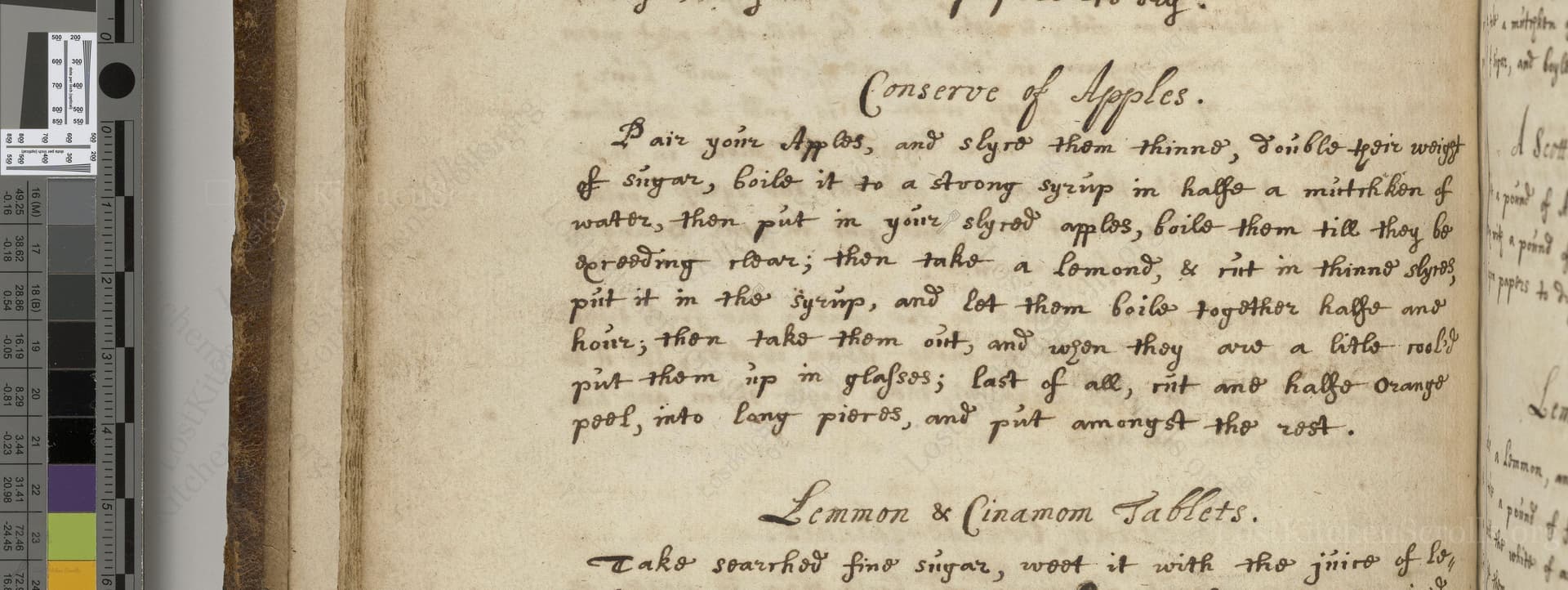Conserve Of Apples
From the treasured pages of Receipt book
Unknown Author

Conserve Of Apples
"Pair your Apples, and slyce them thinno, double their weight of sugar, boile it to a strong syrup in halfe a mutchkon of water, then put in your slyced apples, boile them till they be spreading reare; then take a Lemond, & cut in thinno slyces, put it in the syrrup, and let them boile together halfe and hour; then take them out, and whon they are a litle coole, put them up in glasses; Last of all, cut and halfe Orange peel, into long pieces, and put amongst the rest."
Note on the Original Text
This recipe, like many early modern cookery instructions, reads as a series of directives rather than precise, measured steps. Quantities are relative (such as 'double their weight of sugar'), and instructions assume a degree of intuitive knowledge—such as meaning 'boil to a strong syrup' by eye and texture rather than temperature. Spelling is indicative of 17th-century English (e.g., 'slyce,' 'mutchkon' for mug or small jug, 'reare' meaning soft or just done), and words are sometimes abbreviated or phonetically spelled, reflecting the transition from oral to manuscript cooking culture.

Title
Receipt book (1670)
You can also click the book image above to peruse the original tome
Writer
Unknown
Era
1670
Publisher
Unknown
Background
A delightful voyage through 17th-century kitchens, this manuscript tempts the senses with timeless recipes, forgotten flavors, and the intrigue of historical culinary craft. Savory secrets and sweet indulgences await within its well-worn pages.
Kindly made available by
Folger Shakespeare Library
This recipe hails from an English household manuscript dating to the 1660s–1680s, a period of growing fascination with preserving fruits and sugars as both luxury and necessity. The inclusion of citrus echoes the trade influx of lemons and oranges via colonial expansion, while sugar itself was still a status symbol on British tables. Household preserves like this conserve served both medicinal and culinary roles—both sweetmeat for special occasions and a way to extend the harvest into leaner months.

In the 17th century, this conserve would have been made in a large, heavy-bottomed brass or copper preserving pan, stirred with wooden spoons, and cooked over an open hearth or the coals of a kitchen fire. Apples would be sliced with a sharp knife, and the finished conserve packed into blown glass jars or wide-mouthed bottles, sealed with leather, paper, or cloth ties waxed for preservation.
Prep Time
20 mins
Cook Time
1 hr
Servings
12
We've done our best to adapt this historical recipe for modern kitchens, but some details may still need refinement. We warmly welcome feedback from fellow cooks and culinary historians — your insights support the entire community!
Ingredients
- 2.2 lbs apples (peeled and thinly sliced; use a tart variety such as Bramley or Granny Smith for historical accuracy)
- 4.4 lbs granulated sugar
- 1 1/4 cups water
- 1 whole lemon (thinly sliced, seeds removed)
- Half an orange peel (cut into long thin strips)
Instructions
- To prepare this conserve of apples, begin by peeling and thinly slicing your apples.
- Weigh them and then prepare double their weight in granulated sugar.
- In a large saucepan, combine the sugar with about 1 1/4 cups of water for every 2.2 lbs sugar, creating a syrup by bringing it to a boil and simmering until thickened.
- Add your sliced apples and simmer gently until they begin to break down and thicken, but remain spreadable.
- Next, thinly slice one whole lemon (removing any seeds), and add it to the simmering mixture.
- Cook all together for another 30 minutes.
- Turn off the heat and let the mixture cool slightly.
- Transfer to sterilized glass jars.
- Finally, cut half an orange peel into long strips and stir through before sealing.
- Store in the refrigerator.
Estimated Calories
220 per serving
Cooking Estimates
It takes about 20 minutes to prepare the fruit and equipment, and about 1 hour to cook everything until thickened. This recipe makes about 12 servings, each with roughly 220 calories.
As noted above, we have made our best effort to translate and adapt this historical recipe for modern kitchens, taking into account ingredients nowadays, cooking techniques, measurements, and so on. However, historical recipes often contain assumptions that require interpretation.
We'd love for anyone to help improve these adaptations. Community contributions are highly welcome. If you have suggestions, corrections, or cooking tips based on your experience with this recipe, please share them below.
Join the Discussion
Rate This Recipe
Dietary Preference
Main Ingredients
Culinary Technique

Den Bockfisch In Einer Fleisch Suppen Zu Kochen
This recipe hails from a German manuscript cookbook compiled in 1696, a time whe...

Die Grieß Nudlen Zumachen
This recipe comes from a rather mysterious manuscript cookbook, penned anonymous...

Ein Boudain
This recipe comes from an anonymous German-language manuscript cookbook from 169...

Ein Gesaltzen Citroni
This recipe, dating from 1696, comes from an extensive anonymous German cookbook...
Browse our complete collection of time-honored recipes



